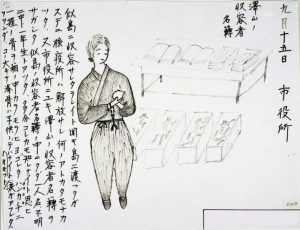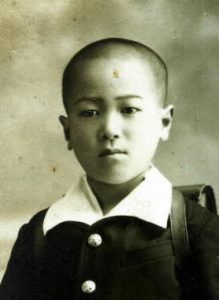Documenting Hiroshima of 1945: September 15, unconfirmed remains of son
Sep. 15, 2024
by Kyosuke Mizukawa, Senior Staff Writer
On September 15, 1945, Tomiko Miyaji, 34 at the time, was unable to locate her only son, Nobukazu, 12, who had gone missing after being mobilized to engage in the work of building demolition for the creation of fire lanes near the hypocenter of the atomic bombing.
Nobukazu was a first-year student at Hiroshima Second Middle School (present-day Kanon High School, in Hiroshima’s Nishi Ward). On August 6, he had been ordered to engage in the building-demolition work in the area of Nakajima-shinmachi (in the city’s present-day Naka Ward). In an unusual statement for him, he had said, “I don’t want to go today.” After his mother sent him off with the words, “Cheer up and go,” the atomic bomb detonated.
Trapped under their house in the area of Nakahiro-honmachi (in Hiroshima’s present-day Nishi Ward), Ms. Miyaji was rescued by her husband. Despite impaired vision due to a swollen face from impaled glass, she walked around looking for Nobukazu. Before long, she developed a high fever and persistent shivering, and on August 10, she was forced to leave Hiroshima and recuperate on her husband’s home of Innoshima Island (in present-day Onomichi City).
After returning to Hiroshima on September 1, she traveled to Ninoshima Island and other places where many of the wounded had been taken but was unable to find her son. With that, on August 15 she visited Hiroshima’s City Hall, a structure that had survived the fires, because it not only was providing consultation for the missing but was also publicly posting lists of the dead and the wounded and handing over remains of those whose detailed identities and families were unidentified.
Later, Ms. Miyaji depicted her memory of that day in a painting of the atomic bombing. On Ninoshima Island, she had found the entry of one person, described as “an unknown first-year student at Second Middle School,” on a list of the wounded admitted there. In the caption of her painting, she wrote, “Thinking perhaps it was him, I removed a handful of bones from the box and wrapped them in a dirty handkerchief.”
However, confirmation that the bones were her son’s was never possible. She wrote, “When I thought the big spine couldn’t be a child’s, tears welled up in my eyes.”
After the war, she lived together with her husband on Innoshima Island. She continued attending memorial services for victims of Second Middle School, but when she was no longer able to do so due to old age, she would send money to pay for incense used in the ceremonies. In her personal account, she wrote, “I want to continue thinking of my child, who died an unfortunate death, for as long as my husband and I are alive without being bothered by anyone.” Ms. Miyaji died in 2014 at the age of 103.
(Originally published on September 15, 2024)
On September 15, 1945, Tomiko Miyaji, 34 at the time, was unable to locate her only son, Nobukazu, 12, who had gone missing after being mobilized to engage in the work of building demolition for the creation of fire lanes near the hypocenter of the atomic bombing.
Nobukazu was a first-year student at Hiroshima Second Middle School (present-day Kanon High School, in Hiroshima’s Nishi Ward). On August 6, he had been ordered to engage in the building-demolition work in the area of Nakajima-shinmachi (in the city’s present-day Naka Ward). In an unusual statement for him, he had said, “I don’t want to go today.” After his mother sent him off with the words, “Cheer up and go,” the atomic bomb detonated.
Trapped under their house in the area of Nakahiro-honmachi (in Hiroshima’s present-day Nishi Ward), Ms. Miyaji was rescued by her husband. Despite impaired vision due to a swollen face from impaled glass, she walked around looking for Nobukazu. Before long, she developed a high fever and persistent shivering, and on August 10, she was forced to leave Hiroshima and recuperate on her husband’s home of Innoshima Island (in present-day Onomichi City).
After returning to Hiroshima on September 1, she traveled to Ninoshima Island and other places where many of the wounded had been taken but was unable to find her son. With that, on August 15 she visited Hiroshima’s City Hall, a structure that had survived the fires, because it not only was providing consultation for the missing but was also publicly posting lists of the dead and the wounded and handing over remains of those whose detailed identities and families were unidentified.
Later, Ms. Miyaji depicted her memory of that day in a painting of the atomic bombing. On Ninoshima Island, she had found the entry of one person, described as “an unknown first-year student at Second Middle School,” on a list of the wounded admitted there. In the caption of her painting, she wrote, “Thinking perhaps it was him, I removed a handful of bones from the box and wrapped them in a dirty handkerchief.”
However, confirmation that the bones were her son’s was never possible. She wrote, “When I thought the big spine couldn’t be a child’s, tears welled up in my eyes.”
After the war, she lived together with her husband on Innoshima Island. She continued attending memorial services for victims of Second Middle School, but when she was no longer able to do so due to old age, she would send money to pay for incense used in the ceremonies. In her personal account, she wrote, “I want to continue thinking of my child, who died an unfortunate death, for as long as my husband and I are alive without being bothered by anyone.” Ms. Miyaji died in 2014 at the age of 103.
(Originally published on September 15, 2024)









